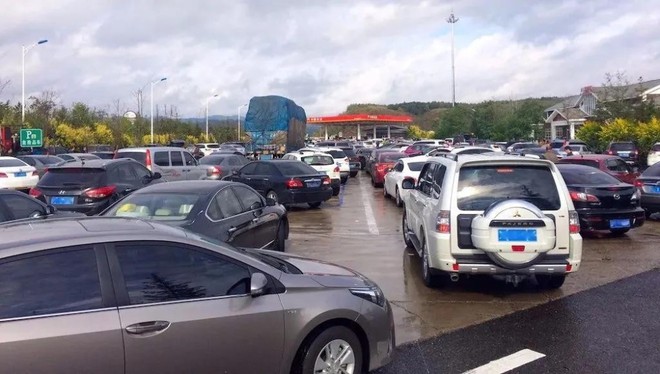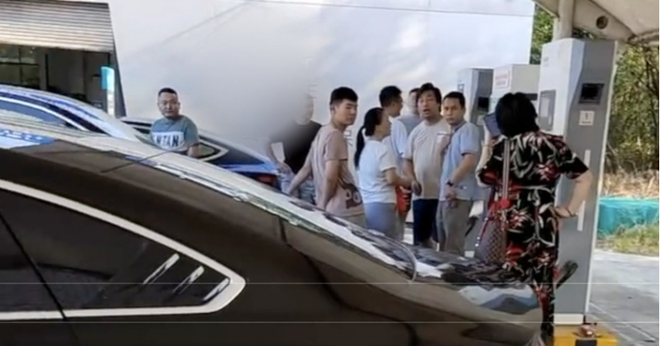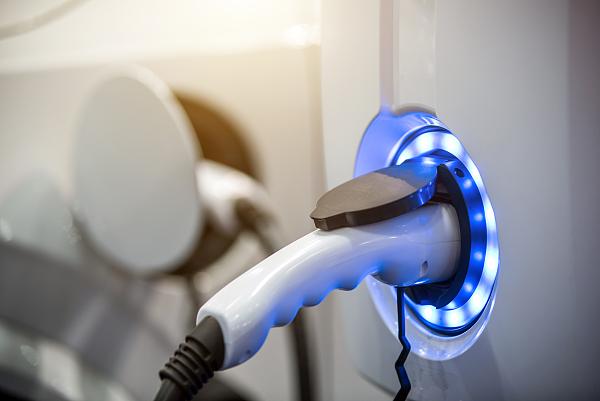Charging takes only 1 hour but queuing takes 4 hours, this is why electric cars are still difficult to travel long distances
- Tram Ho
China is currently the largest and fastest growing market for electric vehicles worldwide. The infrastructure system for new energy vehicles is also invested and developed synchronously and widely by this country.
However, during the last long holiday in this country, many electric car owners had to experience the feeling of “lagging behind” and struggling because of the inherent disadvantages of this type of vehicle when traveling on long distances. long. That’s the obsession with charging the battery.
On the start of the October 1 holiday, according to media reports, many tram owners traveling from Shenzhen to Hunan, during the charging process at Leiyang rest stop on the highway, spent up to 5 hours. Of which, 1 hour to charge and 4 hours just to queue. The whole journey was originally expected to be just over 8 hours, but eventually turned into… 16 hours.

Electric cars jostle to recharge at highway rest stops in China.
Even in many places, due to overcrowding of vehicles, many electric vehicle owners have scrambled to rob each other of their own charging piles. A tram owner at Leiyang station said that during the 4-hour waiting time, this person did not even dare to go to the toilet for fear of being cut in line.
“There were more than 20 cars queuing at that time, but I didn’t care, because I waited in line for at least three hours. Many car owners who came later to see were also discouraged to turn away,” this person said. know.
Another tram owner said that his companion could not wait long, so he got on a friend’s car to go home. And when this person got home, he was still waiting in line to wait for his turn to charge.
This incident has caused a lot of controversy on Weibo in China.
“You can go to work in urban areas with those toy electric cars, but they should not be used for commuting for long distances.”
“These are just a few cars. If everyone were to drive an electric vehicle, the whole highway journey would be extremely haunting. All would be in long lines to recharge.”
“It is recommended to use a hand crank generator, both exercise and save money”

Cars crammed together at a highway stop in China during the past holiday.
The problem is that the charging piles at the rest area on the highway are inherently difficult to find, but when found, there are too many vehicles waiting to use.
In fact, based on statistics, as of the end of September this year, China’s number of new energy vehicles is about 6.78 million units, only 1.7 times higher than 2020. Along with With the increase of this type of vehicle, the number of charging piles also increased rapidly. Currently, the number of charging piles in China is about 2.1 million units, an increase of 52.3% compared to 2020. The ratio of vehicles to the number of piles is 3:1.
It sounds commensurate, but the problem is that when users need to drive long distances through provinces and cities, the number of charging piles in certain areas of the highway is not enough. Because the risk is not only queuing up when charging, but also not finding the charging station on the road, which eventually leads to a situation of running out of power and not being able to drive. This is also the reason why, although very popular, electric cars are still not the means of choice for many people to travel long distances.
According to statistics during the past holiday, daily charging capacity on China’s highways has reached a record high, nearly four times that of a weekday. And to a certain extent, the charging pattern of the poles for long-distance trips is similar to that of train tickets on peak occasions. They will cost more than usual.

Electric vehicle owners line up to compete for charging piles on highways in China.
Everything seems to be solved by building more charging stations for electric vehicles at rest areas. But no, it is not possible to design the reception capacity of any service industry based on the number of visitors during peak periods. Because to meet peak demand, the average annual operation, including maintenance and repair fees, will inevitably cause losses. Like other service industries, electric vehicle charging piles cannot be built much just to meet demand at peak times.
Even at gas stations, queues are congested. However, the problem lies in the fact that refueling a car only takes a few minutes, so congestion at the gas station is usually short-lived. As for electric vehicles, they need at least 1-1.5 hours at the station to charge the battery. The problem of electric vehicles and charging piles can almost only be solved with technology, when new batteries or faster charging technology are born.
Some users also suggest to solve it by replacing the removable battery, but this solution also encounters many difficulties. The first is to convince all electric vehicle manufacturers to follow a few uniform specifications for the battery, like shape and size for the connector, like the smartphone charging standard. Second, the batteries themselves replaced at the stations also need to be charged quickly, otherwise they will not be able to meet the needs of the next vehicle, while the stations cannot back up too many rechargeable batteries. In addition, it is also related to the problem of the power grid to avoid overload.

It can be said that, until now, the uncontrollable risk of running electric cars for long distances is still too great, especially through areas with frequent traffic jams. With electric cars, when the amount of energy is low, many car owners do not even dare to turn on the air conditioner and use the entertainment facilities on the car. During the recent Chinese holiday, in areas with prolonged traffic jams, the scene of many families taking trams having to sit on the side of the road to relax has become extremely common and become a satirical story of many people. riders using conventional fuels.
According to industry experts, to some extent, the situation of crowded queues for electric vehicle charging in station areas in China will persist for a long time. But looking at it optimistically, under the premise of the explosive growth of new energy vehicles, there is still plenty of room to continue to improve and develop charging technology for the future.
Refer to NetEase
Source : Genk
